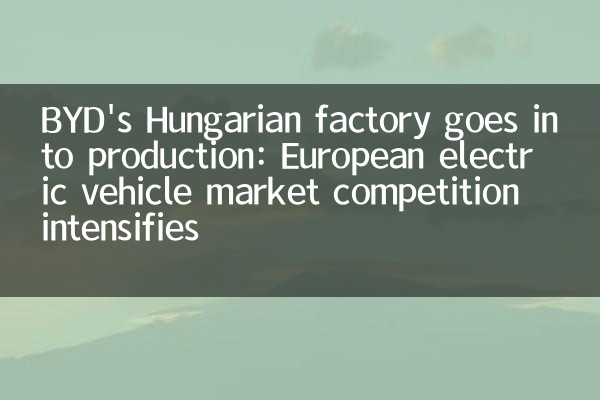BYD's Hungarian factory goes into production: European electric vehicle market competition intensifies
Recently, the global new energy vehicle market has caused another wave. China's new energy vehicle giant BYD officially announced the start of production of its Hungarian factory, marking a key step in its European localization strategy. This move will not only reshape the European electric vehicle market structure, but also inject new impetus into the transformation of the global automobile industry.
1. Event background and core data

The BYD Hungarian factory is located in the southern city of Komarom, the country. The total investment is about 1 billion euros and the annual production capacity is expected to reach 150,000 vehicles. Here are the key data for the project:
| project | data |
|---|---|
| Geographical location | Komarom, Hungary |
| Area | 300 hectares |
| Total investment amount | 1 billion euros |
| Annual production capacity | 150,000 vehicles |
| The first mass-produced model | ATTO 3 (metal PLUS) |
| Localization rate target | 80% (2026) |
2. Current status of the European electric vehicle market
The European market is undergoing an unprecedented transformation of electrification. According to the latest statistics:
| index | 2022 | 2023 (Estimated) | growth rate |
|---|---|---|---|
| Electric car sales | 2.6 million vehicles | 3.1 million vehicles | 19.2% |
| Market penetration | 21.6% | 25.3% | 3.7 percentage points |
| Number of public charging piles | 445,000 | 578,000 | 29.9% |
| Chinese brand market share | 8.2% | 12.5% | 4.3 percentage points |
3. BYD’s European strategic layout
BYD's construction of a factory in Hungary this time is an important part of its "global localization" strategy. Currently, BYD has formed a complete layout in Europe:
| nation | Business Type | Investment scale | Startup time |
|---|---|---|---|
| Hungary | Vehicle manufacturing | 1 billion euros | 2024 |
| Germany | R&D Center | 200 million euros | 2021 |
| France | Battery recycling | 150 million euros | 2023 |
| Netherlands | Logistics Center | 80 million euros | 2022 |
4. Analysis of market competition pattern
The addition of BYD has made competition in the European electric vehicle market more intense. The market performance of major manufacturers is as follows:
| brand | Sales in 2023 | Main model | Price range (Euro) |
|---|---|---|---|
| Tesla | 482,000 vehicles | Model Y | 45,000-65,000 |
| public | 385,000 vehicles | ID.4 | 40,000-55,000 |
| Renault | 221,000 vehicles | Megane E-Tech | 35,000-50,000 |
| BYD | 156,000 vehicles | ATTO 3 | 30,000-45,000 |
5. Industry impact and future prospects
The opening of BYD's Hungarian factory will have multiple impacts: first, its more competitive price strategy (15-20% lower than similar products) will force European car companies to accelerate cost reductions; second, a complete local supply chain will enhance the recognition of Chinese brands in Europe; finally, under the EU's carbon tariff policy, localized production will become an inevitable choice for multinational car companies.
Experts predict that the European electric vehicle market size will exceed 5 million by 2025, and the market share of Chinese brands is expected to reach 20%. The joining of Chinese automakers such as BYD will not only bring about product competition, but will also promote technological upgrades and service innovation in the entire industrial chain, and will ultimately benefit global consumers.
As Hungarian factory capacity climbs, BYD plans to launch six new electric models in Europe by 2025, covering the entire product line from compact sedans to large SUVs. This European electric vehicle market transformation led by Chinese automakers has just begun.

check the details

check the details